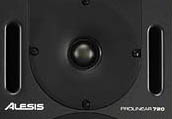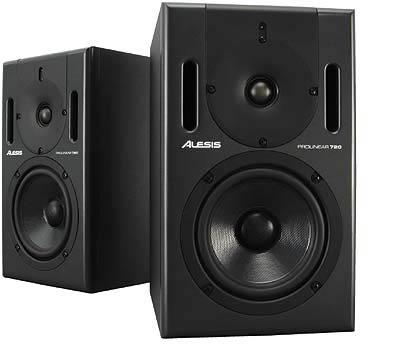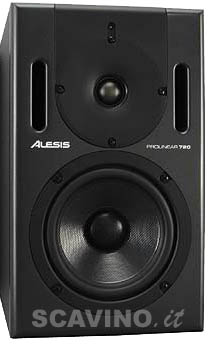|
Caratteristiche principali PProLinear 720 - State
of the Art Sound at an Affordable Price
The Alesis ProLinear 720 continues the new standard in near-field
monitors set by the ProLinear 720 DSP, but at a lower price. With custom
DSP technology, Alesis was able to design a speaker with sound quality
and accuracy for a low price. Clarity, imaging and transient response
are truly outstanding. Bass is tight and visceral. We have compared the
ProLinear 720 to some of the most popular monitors costing many times
more and its performance was considered superior by all listeners. The
primary difference between the 720 and 720DSP is the lack of user EQ
control with the 720. The crossover and fixed EQ voicing are essentially
the same.
ProLinear 720 Features
It Begins with the Drivers
Any great speaker design starts with the best drivers and the Alesis'
custom drivers are exceptional. The woofer has a cast frame with a 7"
Kevlar cone and oversized magnet assembly. The Kevlar cone has
outstanding stiffness to weight ratio to minimize distortion, extend
bass response and provide excellent transient response. The magnet
assembly provides high linearity and good efficiency. In the 720
cabinet, the woofer is flat down to 43hz (-3db, anechoically) with
harmonic distortion typically below 0.4% above 50hz.
The tweeter is a 28mm silk dome that has a very flat frequency response
with a low resonance to reduce harshness. The tweeter is ferro-fluid
cooled to provide good power handling and well-behaved response.
Distortion is typically below .3% over its operating range. The tweeters
computer designed waveguide was optimized for nearfield placement but
provides excellent imaging in most other placements.
Both drivers are shielded and allow the user to place the speakers
within a few inches of a CRT.
The Crossover
With Alesis' custom DSP processing, the crossover for the drivers
achieves a linearity that is usually unachievable in analog monitors.
This allows a smooth transition of the sound between the tweeter and
woofer as well as providing proper time domain coherency. In other words,
the speaker is as accurate as the drivers. The DSP also allows us to
smooth out the frequency response far more effectively than with analog
monitors. The response is typically better than +/- 1dB between 100hz
and 20Khz.
The Electronics
The ProLinear is bi-amplified with typically 80 watts for the woofer and
40 watts for the tweeter. (In actuality, the woofer and tweeter are both
powered at 80 watts, but because of the higher efficiency and lower
power content to the tweeter, only about 40 watts is needed to match the
80 watts to the woofer.) The amplifiers are low distortion, wide band
devices that are self-protected to prevent damage to the drivers. Inputs
are either analog XLR or �" TRS, so digital mixers and sources are not
required.

ProLinear 720 Specifications
Input:
Nominal input level: +4dBu
(-15dBFS). Maximum input level: +20dBu (7.0 Vrms)
Input impedance: 10k?
Output:
Sound Pressure Level (SPL): ~110db at 1 meter at max input below
clipping.
Low Frequency (LF) power: 80 watts RMS, ~120 watts peak.
High Frequency (HF) power: 40 watts RMS typical, ~120 watts peak.
Frequency response: 50hz - 20kHz +/- 1.5dB. Bass level -3dB @ 43hz
typical,
Signal To Noise ratio: > 90 dB A-weighted, Analog In to Analog Out,
Power Requirements:
Input voltage: 100v - 230v
Input frequency: 47 - 63 Hz
Power consumption: 20 W (idle)
130 W (typical, at maximum volume)
Environmental Requirements:
Temperature range: 0-40 degrees C. Relative humidity (non-condensing):
30-85%.
Cabling Requirements:
Mixer to Speaker: Balanced or unbalanced, shielded; XLR or �" TRS
connector.
Mechanicals:
Size (HxWxD): 15" x 9" x 12" (380mm x 230mm x 305mm)
Weight: 25lbs (11.4kg)
Disclaimer:
The features and specifications of the Alesis ProLinear Monitors are
subject to change at any time without notice. |
 N.B.: Il prezzo è
inteso per la cassa singola!!! |



































